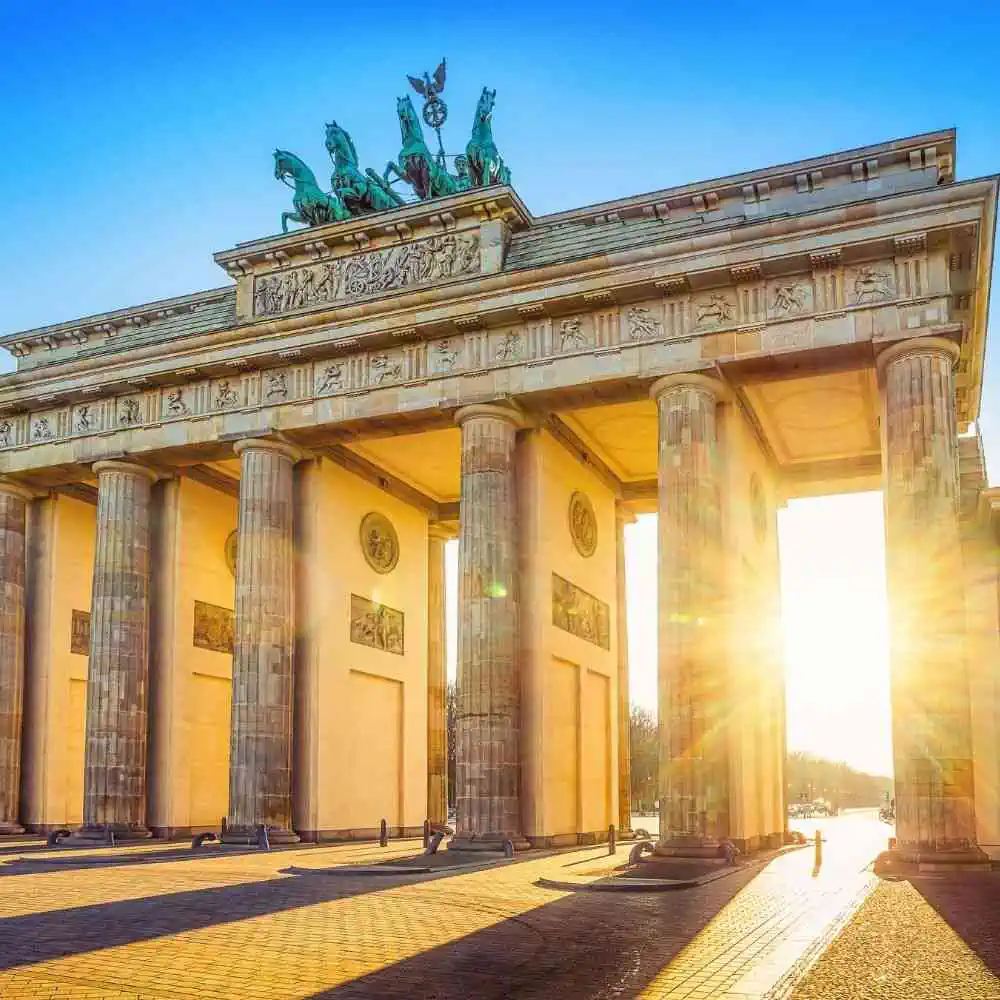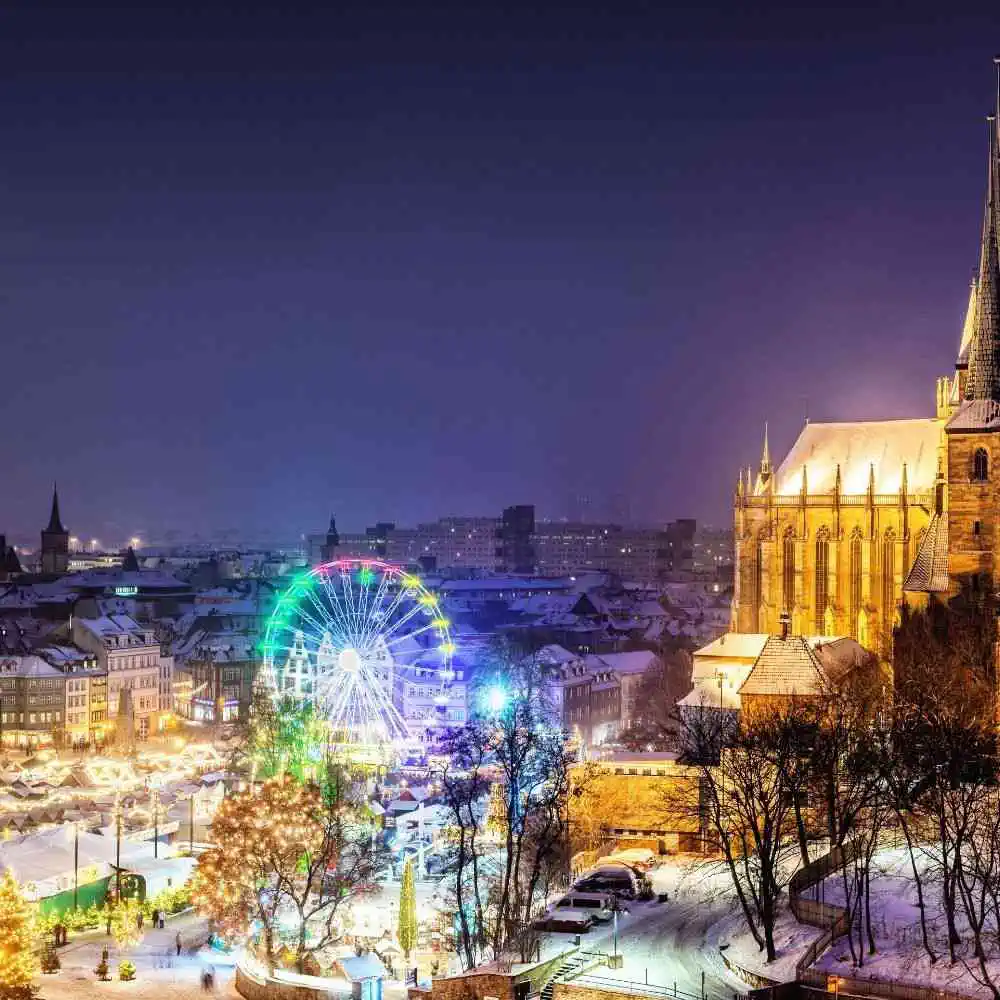Você partirá de Estação Central de Erfurt, localizado bem no centro da cidade de Erfurt, e desfrutará da bela paisagem da viagem enquanto chega em Estação Central de Berlim, também localizada no coração de Berlim.
Comboios de Erfurt para Berlimde $ 32.64
Comboios de Erfurt para Berlim
Viajando de comboio: Erfurt - Berlim
Take a journey on an imperial rail ride from Erfurt to Berlin and explore the towns along the way! With a 6-hour train journey passing through the range of iconic cities & towns, this route is a traveler's dream. Discover the key stations, duration, and sights to make this a journey to remember! Departure from Erfurt: The Eisenbahn train departs from Erfurt commuter railway station, located in the heart of the city. The station itself has a long history, beginning as a terminal station in 1846 and was a major cargo hub for central Germany. The station is also known for its impressive architecture, with its sandstone and brick facade, making it an iconic sight. Main Stations:
The most important stops along this route include Leipzig, the beautiful city of Halle, and Magdeburg. From Leipzig, the rail curves through the tranquil flatlands of rural Brandenburg province, before arriving in Halle. As a major city, it is the largest in the region and has many points of interest, including the Marktplatz and the Moritzburg Palace. Finally, the journey ends in Magdeburg, a UNESCO World Heritage city full of stunning churches and architecture. Arrival in Berlin:
The destination of this journey is Berlin, the bustling capital of Germany. Upon arriving at the main station, travelers will be met with a stunning view of the skyline. As a major international hub, Berlin has a wealth of culture, art, and architecture to explore. There is something for everyone in this vibrant city! Duration:
The total duration of this journey is approximately six hours, with a distance of about 250 miles. Although the length may seem daunting, much of the route takes place on high-speed rail lines that make the trip fly by. Conclusion:
Traveling from Erfurt to Berlin on the Eisenbahn is an unforgettable experience. Passengers can enjoy beautiful towns, fascinating history, and breathtaking views of the German countryside. There is something for everyone on this imperial rail ride, making it a journey to remember!

Detalhes da viagem
How long does the train from Erfurt to Berlin take?
The train from Erfurt to Berlin takes around 3 hours and 15 minutes.
What is the fastest journey from Erfurt to Berlin by train?
The fastest journey from Erfurt to Berlin by train is 3 hours and 10 minutes. There are also several trains that take around 3 hours and 30 minutes.
How much does the train cost from Erfurt to Berlin?
The cost of the train from Erfurt to Berlin is between €29 and €59 Euros. The exact price depends on the time, date and type of ticket you choose.
How much does the Erfurt to Berlin?
Yes, there is a direct train from Erfurt to Berlin that takes approximately 3 hours and 15 minutes.
What is the distance from Erfurt to Berlin by train?
The distance from Erfurt to Berlin by train is around 243 kilometers (151 miles).
Which are the cities that the train stops from Erfurt to Berlin?
The train stops in cities such as Halle (Saale), Magdeburg, Leipzig, Bitterfeld-Wolfen, Dessau and Brandenburg an der Havel.
Erfurt: Locais para ver
Erfurt is one of the oldest cities in Germany, located in the heart of the Thuringia province. It has a rich history, full of fascinating architecture, monuments, and culture. A trip to Erfurt promises to offer a unique insight into Germany’s past, with plenty of opportunities to explore and discover. Here are seven of the best places to visit and what to eat when you’re in town.
Church of St. Severus: The Church of St. Severus is the oldest structure in Erfurt, dating back to the 8th century. Its Romanesque and Gothic-style architecture and impressive vaulted ceilings make it truly one of a kind. Entrance to the church is free, and it’s open from 10am to 4pm. Make sure to check out the elaborate altarpiece and the 11th-century baptismal font.
Krämerbrücke: The Krämerbrücke is an iconic bridge in Erfurt with a remarkable history. Built in 1325, the bridge, spanning over the Breitstrom river, contains over 30 quaint, half-timbered houses built during the Middle Ages. Today, many of these houses are filled with small shops selling traditional Thuringian handicrafts and souvenirs.
Erfurt Cathedral & Chapel: This Gothic structure is home to the city’s most important religious buildings. Erfurt Cathedral, built in the 13th century, is an impressive sight, with fascinating artworks and a great view of the city. The Chapel of St. Mary, which dates back to 1490, is another architectural gem and is open from 10am to 5pm.
Merchants' House: One of Erfurt’s oldest homes, the Merchants' House is a delightfully preserved building from the Middle Ages. Located in the heart of the city, the house was originally constructed in the 13th century and remained in the same family until World War II. It now serves as a museum and is open daily from 10am to 5pm.
Fischmarkt: This old-fashioned market square is the ideal spot to pick up some fresh produce and other treats. You’ll find stalls selling all kinds of food, and the local specialties such as Thüringer Rostbratwurst and Thüringer Klöße, a type of dumpling, are a must-try.
Moritzburg Fortress & Museum: Perched on a hill overlooking Erfurt, this magnificent fortress, built in the 14th century, is a sight to behold. It’s now home to a museum of Thuringian history, with a collection of coins, weaponry, and artwork from the Middle Ages. Entrance to the museum is free, open from Tuesday to Sunday between 10am and 4pm.
St. Augustine's Monastery: This stunning Romanesque-style monastery was once the site of Martin Luther’s religious awakening. Today, the monastery houses the university library and is open to visitors from 10am to 4pm.
Erfurt is the perfect destination for anyone looking for an unforgettable trip full of history and culture. Make sure to try some of the city’s delicious traditional dishes and explore its unique architecture. You’re sure to have a memorable experience!

Berlim: Locais para ver
Berlim, a vibrante capital da Alemanha, é uma cidade que mescla perfeitamente o antigo com o moderno, oferecendo uma viagem inesquecível através do tempo e da cultura. De monumentos que narram histórias de guerras e triunfos a um cenário gastronômico que encanta qualquer paladar, Berlim é um destino que promete experiências memoráveis. Mas o que torna Berlim tão especial? Vamos descobrir juntos.
Aqui estão sete locais históricos e arquitetônicos que você não pode perder em Berlim:
Portão de Brandemburgo: Símbolo icônico da cidade e testemunha de uma Alemanha dividida e reunificada. Localizado no coração de Berlim, ideal para ser visitado tanto de dia quanto à noite.
Muro de Berlim e East Side Gallery: Uma parte preservada do muro que separava o Oriente do Ocidente, hoje transformada em galeria de arte a céu aberto, destacando a resiliência e criatividade humana.
Reichstag: Sede do Parlamento alemão, famoso por sua cúpula de vidro desenhada por Norman Foster, onde você pode aprender sobre a política alemã e desfrutar de vistas panorâmicas da cidade.
Museu da Ilha: Um complexo de museus que abriga tesouros da arte e da história mundial, incluindo o famoso busto de Nefertiti. Uma visita obrigatória para amantes da arte e da história.
Memorial do Holocausto: Um poderoso memorial aos judeus assassinados durante o Holocausto, consistindo em 2.711 blocos de concreto dispostos em uma grade, criando um impacto visual e emocional forte.
Checkpoint Charlie: Um dos pontos de passagem mais conhecidos durante a Guerra Fria, hoje um museu que conta histórias de ousadas fugas e conflitos ideológicos.
Palácio de Charlottenburg: O maior palácio de Berlim, um espetáculo de arquitetura barroca, com jardins magníficos, ideal para um passeio relaxante.
Viajar por Berlim é como caminhar por um livro de história vivo, cada esquina revela uma nova página. A cidade é facilmente navegável por transporte público, incluindo comboios, autocarro e trams, tornando a exploração de seus tesouros históricos e arquitetônicos uma aventura acessível e enriquecedora. Não esqueça de experimentar a culinária local, desde a tradicional salsicha alemã até a moderna cozinha fusion, Berlim tem sabores que agradam a todos. Mergulhe na história, desfrute da arte, saboreie a culinária e deixe Berlim capturar seu coração.

Erfurt: Principais estações de comboio
The main train station of Erfurt, in Germany is Erfurt Hauptbahnhof. This is one of the largest stations in the city, servicing thousands of travelers daily. There are also some other train stations, such as Erfurt West, Erfurt Süd, Erfurt Nord and Steigerwaldbahnhof.
The Erfurt Hauptbahnhof is located at Willy-Brandt-Platz 3, 99084 Erfurt. Opening hours are from 5:00 a.m. to 0:30 a.m. daily. The station has luggage storage facilities with prices ranging from €5.00 to €10.00 per 24 hours. The contact telephone number is +49 361 6511-0.
- Estação Central de Erfurt
- Erfurt Nord
- Erfurt-Gispersleben
- Erfurt-Bischleben
- Erfurt Ost
Berlim: Principais estações de comboio
A Berlim é servida por várias estações ferroviárias, mas a Estação Central de Berlim (Hauptbahnhof) destaca-se como a principal porta de entrada para a cidade e uma das mais importantes da Alemanha. Além dela, outras estações relevantes na cidade incluem Ostbahnhof e Südkreuz, facilitando o acesso a diferentes partes da cidade e oferecendo conexões para várias regiões da Alemanha e da Europa.
Localizada na Europa-Platz 1, a Estação Central de Berlim funciona diariamente, oferecendo uma ampla gama de serviços aos viajantes. Entre os serviços disponíveis, o de consignação de bagagens é particularmente útil para aqueles que desejam explorar a cidade sem o incômodo de carregar suas malas. Os horários de funcionamento variam, mas geralmente a estação está aberta 24 horas, garantindo flexibilidade para os horários de chegada e partida dos viajantes.
- Estação Central de Berlim
- Berlin Hbf (S-Bahn)
- Berlin Schönefeld Flughafen
- Berlin Charlottenburg
- Berlin Ostbahnhof
- Berlin Gesundbrunnen
- Berlin Südkreuz (S)
- Berlin Spandau
- Berlin Potsdamer Platz
- Berlin Zoologischer Garten
- Berlin Lichtenberg
- Berlin Hohenschönhausen
Erfurt - Berlim: Como conseguir as melhores ofertas
Reserve com Antecedência:
Assim como nas passagens aéreas, os preços dos bilhetes de comboio tendem a aumentar à medida que a data de partida se aproxima. Reservar com semanas ou até meses de antecedência pode economizar uma quantia significativa.
Viaje Fora do Horário de Pico:
Evite viajar em horários de pico, como nas manhãs e noites de dias úteis. Opte por viagens ao meio-dia, no final da noite ou durante a semana, quando há menos demanda.
Considere comboios mais lentos ou rotas não diretas:
Os comboios expressos ou de alta velocidade podem economizar tempo, mas geralmente são mais caros. Optar por serviços regionais ou mais lentos pode reduzir sua tarifa.
Procure por Ofertas Especiais e Promoções:
Os operadores de comboios ocasionalmente têm promoções ou ofertas especiais, especialmente durante a temporada de baixa demanda. Vale a pena se inscrever para receber newsletters. Além disso, às vezes existem descontos para grupos ou para bilhetes de ida e volta, então considere essas opções se elas se encaixarem em seus planos de viagem.
Tudo o que necessita saber sobre
Precisa da nossa ajuda?
- Contacte-nos
Pagamento seguro garantido
Certificados


